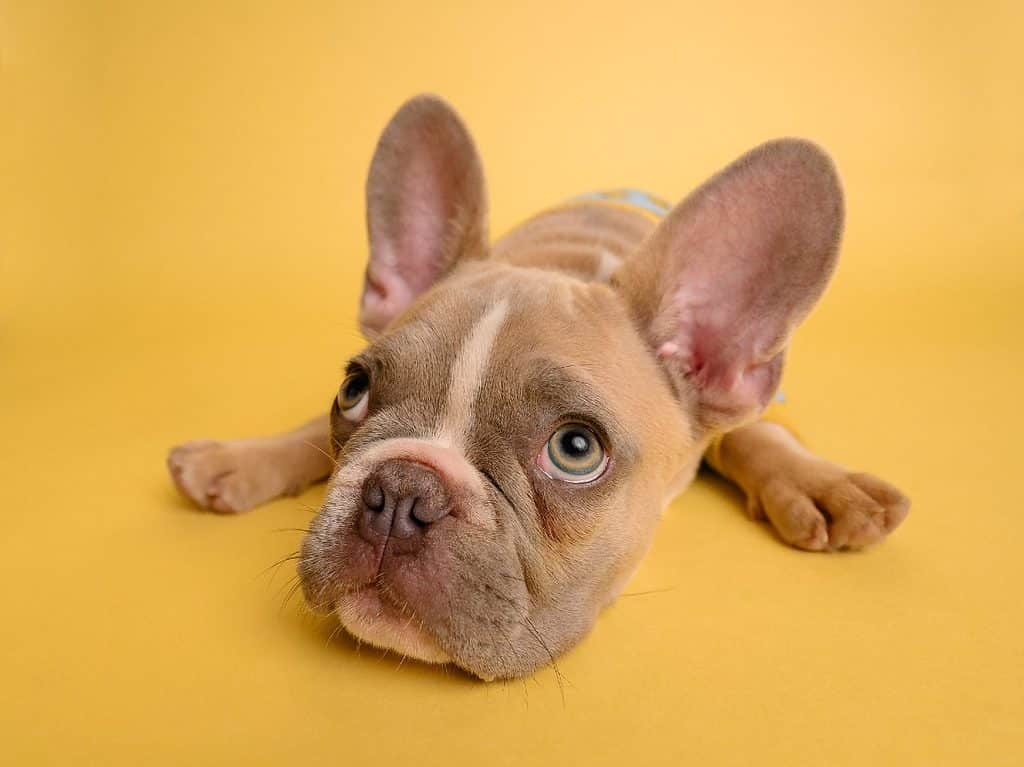Ever notice your pup’s ears are cold to the touch? It may be more than just a sign of how chilly it is outside. Since your furry friend cannot tell you what’s bothering them, you have to unlock your Sherlock Holmes skills and uncover the reason for their cold ears.
Don’t worry; this guide can help if you’re playing detective. Here we discuss five reasons why dog’s ears are cold and provide helpful solutions for keeping them warm and cozy.

Reasons Why My Dog’s Ears Are Cold
1. Circulation Issues
The main reason a dog’s ears feel cooler than the rest of its body is poor circulation around the ear area. This means that there isn’t enough blood flowing in and out of those cute little flaps, resulting in a lack of warmth. It could indicate that your pup has an underlying medical issue, such as heart disease and anemia, which makes it more difficult for their blood vessels to provide enough warmth throughout their body.
What should you do if your dog’s ears feel cold due to circulation problems? Take your pup for a check-up with the vet. They can rule out any serious underlying health issues and suggest the best course of action.
The most important treatments for heart disease in dogs include diet adjustments, drugs or supplements such as omega-3 fatty acids or diuretics that help reduce fluid buildup around the lungs or other organs; surgery may also be an option depending on the condition’s severity.
Furthermore, depending on what is causing the anemia in dogs, your veterinarian may recommend medications such as iron supplements or antibiotics for infection; and blood transfusions for severe cases.
If your dog’s attitude shifts abruptly in conjunction with cold ears, you must not take this issue lightly.
2. Dehydration
It’s not just humans who feel the effects of dehydration. If your pup’s ears are feeling chilly, it may be a sign that they’re not getting enough fluids in their diet.
Dehydration is common among dogs and can cause more than cold ears. When dogs don’t get enough water, their body starts to shut down essential functions like circulation and digestion. When their circulation is affected, the blood vessels around their ears constrict, making them appear cooler than average.
Additionally, when digestion slows down from lack of hydration, the nutrients necessary for keeping organs healthy won’t be metabolized properly, and this could lead to decreased warmth throughout the body.
So how do you keep your pup hydrated? Make sure there is always fresh, clean water available!
Your dog’s water intake depends on its activity level and the environment they live in. Dogs need more water in hot climates or if they are expending energy through play or exercise. You should also consider your pet’s age when determining how much water they need; older dogs generally require more water than puppies due to decreased mobility and metabolism.
3. Cold Temperature

A cold snap can be a tricky time for dogs and their owners. Some dogs may experience a chill and shiver in their ears as temperatures drop.
Even though dogs have fur coats that keep them warm in winter, their ears and nose are often left exposed and can be affected by the elements more quickly than other parts of their bodies, including the tails.
It doesn’t take long for the cold to cause discomfort and pain for your pup. So if possible, limit outdoor activities in extreme weather conditions; this will reduce exposure time and help keep them warm.
You can also use a cozy pair of ear covers if your pup is comfortable using them. Not only do these keep their delicate ears warm for those extra-cold days, but they also add a stylish touch to your dog’s look. You can let your dog wear a hat or bandana if you don’t have ear covers at home.
More importantly, ensure your dog has a warm place to curl up in during freezing weather. If they don’t have access to a sheltered area, such as an enclosed porch or garage, think about investing in a pet house with thick walls that will help keep them insulated from the elements.
Frostbite
Dogs can suffer severe injury if exposed to extreme cold without proper protection. If a dog spends too much time in subzero temperatures or is outside without adequate shelter and insulation, their skin and paw pads will begin to freeze, resulting in severe tissue damage.
Once frozen, the affected area may become blackened and necrotic, essentially dead tissue, which can cause infection and even lead to amputation if left untreated.
Frostbite on a dog’s ears can happen quickly or over time, depending on the severity of cold weather conditions or how long they’re exposed. If you notice your dog’s ears turn bright pink, take him inside immediately; this could be an early sign of frostbite taking hold.
4. Hypothyroidism
Did you know that if your dog’s ears are cold, it could be a symptom of hypothyroidism? It’s true; when dogs have low levels of thyroid hormone in their bodies, their metabolism slows down, and so does the temperature of their ears.
In addition to colder ears, other signs and symptoms may include dry skin and hair loss, weight gain or difficulty gaining weight, fatigue or lack of energy, increased sensitivity to cold temperatures and sluggishness. With prompt attention from your vet these symptoms can be reversed with effective medications.
Your vet will likely recommend a thyroid hormone supplement that helps restore thyroid hormone levels to normal.
5. Parvo
If your pup’s ears feel cool or cold to the touch, especially if they have recently been exposed to another sick dog, it could be an early sign of infection with parvo. While this doesn’t necessarily mean your pup has Canine Parvovirus (Parvo), it should warrant further investigation from your vet as soon as possible.
Other signs such as vomiting, diarrhea, and lethargy are also common symptoms of this deadly virus.
As a dog owner, you should act quickly when parvo is suspected, as it attacks rapidly dividing cells in their bodies and weakens their immune systems. Parvo is a highly contagious virus and one of the puppies’ top causes of death.
The first step in curing Parvo in dogs is to seek immediate veterinary care. Your vet will test your pup for the presence of the virus and provide medication that can help break its cycle and destroy the virus within its body. During treatment, they may need an IV or fluids to prevent dehydration. The vet may also give them antibiotics to help their weakened immune system.
Additionally, dietary supplements such as probiotics may be prescribed to help rebuild their gut health after recovery.
So how do you know if your puppy will survive parvo? Here are five encouraging signs.
Which Breeds Are More Susceptible To Getting Cold Ears?
The canine’s age, breed, size and living environment can influence its ability to adapt to cold temperatures.
Puppies and Senior Dogs
New owners need to understand that their pup’s body temperature differs from an adult dog’s, one key difference being that young puppies have less body heat to lose. This means they’re more likely to get cold ears, so owners should take extra precautions when the temperatures dip.
Puppies also haven’t fully developed their furs yet, which is supposedly their best defense against freezing temperatures.
Likewise, senior dogs naturally have a lower capacity for retaining body heat due to age-related muscle and fat loss. This makes them more prone to cold ears and other cold-related issues.
Breeds With Short Hair
Short-haired breeds include Pugs, French Bulldogs, Pug Pitbull Mixes, Cane Corso Pitbull Mixes, Bully Kuttas, and Beagadors.
Unlike their long-haired counterparts, they don’t have thick insulation from the cold winter winds. As temperatures drop, pet parents can ensure these dogs stay snug by investing in snuggly sweaters or jackets.

Additionally, heated dog beds and comfy blankets offer a safe and reliable way of keeping your four-legged friends at a comfortable temperature no matter how low the thermostat drops outside.
Breeds With Large, Upright Ears
Having a dog with large, erect ears can be seriously adorable, but it also comes with some downfalls. It turns out that large and upright ears create an area for cold air to gather around them.
It’s important to keep an eye on your pup if they fall into this category. Again, the best way to prevent cold ears is by using ear muffs or hats that cover their little lobes up.
Small Or Toy Breeds
Smaller ones in the canine family can be more susceptible to losing heat quicker and have colder ears than their larger counterparts. These include Chihuahuas and Teacup Pugs.
Owners of these smaller pups should consider limiting trips outside during severely cold temperatures.
Breeds Raised In Warm Climate
Dogs raised in warmer climates are more likely to get cold ears than those bred in cooler areas.
If your pup has been living his whole life in tropical weather, you should ease him into the chillier side of things when temperatures start dipping. After all, it can take some time for a dog from a warmer climate to acclimate to the frosty air outside.
A good place to start is by finding the right gear for your pup; think sweaters or coats for chilly days out on walks.
Ultimately, be sure to check their ears often!
How Can You Tell If Your Dog Is Too Cold?
Firstly, a shivering dog is an obvious sign that it’s time for a sweater or coat. Dogs with short fur may shiver more than those with longer coats, but all breeds should be bundled up when temperatures dip below freezing. If your pup starts curling into itself or trying to find shelter under furniture, this could indicate it’s feeling cold.
Also, take note of your pet’s behavior: does he seem sluggish or less energetic than usual? Cold conditions can sap energy from even the most active pets.
Additionally, look out for behaviors such as whimpering and huddling close to other pets or people.




